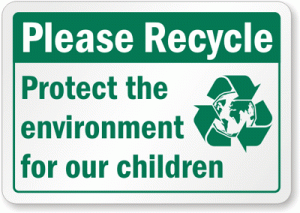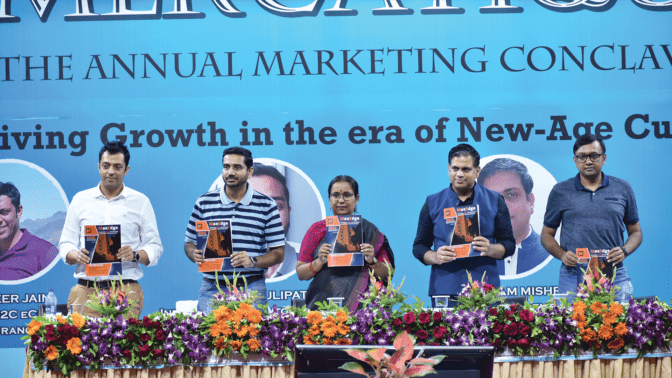In 1985, Michael Porter gave the concept of ‘Value chain’ in his best- seller ‘Competitive Advantage: Creating and Sustaining Superior Performance’, of which supply chain is an integral part. Two of the five primary activities: In-bound logistics & outbound logistics are explicit supply chain functions and in the other three activities also supply chain plays a vital role.
 |
| Please Recycle Label (Photo credits: www.recyclereminders.com) |
When thinking about improving the productivity, enhancing customer satisfaction and reducing costs, supply chain plays a very important role. The importance of supply chain for a business is manifested in how it helps meet customer’s expectations. For example, it can be seen in Walmart’s same day home delivery system, Amazon’s efficient distribution system and Fedex’s overnight courier delivery. All of them are based on some of the most efficient algorithms & systems developed for logistics.
GREEN SUPPLY CHAIN
The concept of ‘sustainability’ arose as a result of challenges like increasing price of conventional energy sources, depletion of other natural resources, global warming and increasing gap between rich & poor with improving living standards. Michael Porter, the strategy wizard, called it ‘creating shared value’ where as Philip Kotler, the marketing guru, called it ‘marketing 3.0’. Nevertheless, these challenges forced businesses to realize the importance of sustainability. And today when companies are looking at enhancing the sustainability of their businesses models, supply chain management is at the forefront again. Businesses have realized that without preserving the nature and without inclusive growth they will not have avenues for growth. This lies in the fact that for their growth they need customers, they can’t do it alone.
‘Greening’ the supply chain has been the buzz word in the industry for quite some time now. The concept of green supply chains might well have started when in 1971 some professionals identified the ways to return the solid waste from distribution channels categorizing the waste into hazardous, non-hazardous and recyclable categories. Over the time concepts like green designing, recycle oriented manufacturing, incorporation of green & environmental issues in strategic planning and performance measurement for green supply chains emerged before the new millennium. In 2001, first version of Green House Gas protocol, a carbon accounting tool for supply chain was released. In the new millennium green purchasing, clean transportation, auditing of green supply chains and reverse logistics seen as new business opportunity have emerged as new focus areas.
INITIATIVES AND PRESENT TRENDS
The more the companies are focussing on sustainability, the more they are realising that the challenges are not from the inside but from outside. Many corporations have setup corporate sustainability targets and have started working towards achieving them with full commitment. To make them effective the pay packages of the top executives are also linked to these targets. By 2020, Unilever targets to double its revenues while halving the company’s environmental impact, which is a very ambitious target and as per the company’s sustainability progress report (2011) they seem to be on track to achieve it.
Similarly, Novelis, the world leader in rolled aluminium has targeted to increase the use of recycled aluminium to 80% by 2020 which was at around 30% in 2009, it will significantly bring down the environmental impact. Novelis estimates that recycled aluminium avoids 95% of the green house gas emissions associated with primary aluminium production and every metric ton of recycled aluminium saves around 7.8 metric tons of carbon dioxide equivalents over the total aluminium value chain. For achieving this Novelis has taken many initiatives like, expanding its scarp sourcing capabilities- it collects cans, scrapped vehicles, wires, foils, cables & extrusion scrap. It is forming new sales contracts with scrap buyback clauses and has also put in place a code of conduct for suppliers.
E-PROCUREMENT: Consider the figures estimated by a business week article, American businesses generate 48.64 billion invoices a year spending $ 24 billion and expending 1 billion trees in the process. E-procurement, the paperless procedure of coordination amongst suppliers, companies & dealers not only ensures that the environment is greener but it has also proved more accurate and efficient. E-invoicing not only saves the trees but also reduces the cost of handling, postage & transportation. This is evident in the fact that all telecom companies now provide 1% discount to customers who are availing the e-bill facility rather than the paper one.
SUPPLIER PARTNERSHIPS: Today most of the companies are collaborating with their suppliers to bring out innovations in green management, though they follow different approaches. GE works with Life Cycle Analysis (LCA) tools to help find out what product and hence the supplier to target so as to reduce the maximum impact on environment. Walmart, on the other hand, follows the Pareto’s 80/20 approach, where it called its 200 biggest suppliers accounting for 70-80% of the business and collaborated with them to reduce environmental impact.
Companies are carefully choosing only those suppliers who are amplifying their march towards sustainability by themselves being sustainable. For example, by reducing carbon footprint in the transportation of material or by using material which is derived without causing harm to the nature. Also, corporations are coming out with many ideas to improve the environmental impact of their logistics system. A group of more than 80 manufacturers, retailers & NGOs including industry champions like Nike, Walmart, Levi’s etc collaborated to form Sustainable Apparel Coalition. This coalition launched ‘The Higgs Index’ which measures the environmental and social performance of apparel and footwear products. Moreover, Nike has further committed to eliminate the discharge of hazardous chemicals throughout its supply chain by 2020, for which it has developed Nike Materials Sustainability Index which is also applicable to suppliers.
CLOSED LOOP SUPPLY CHAIN: When Dan Guide, professor at Penn State University asked his students to associate word ‘Green’ with another word, most of them chose the word ‘new’. This is typically the mindset of today’s consumer. It has happened due to ‘make-use-dispose’ business model used by companies. On the contrary, Xerox has adopted a different business model, instead of selling their machines they lease and service them. They precisely know what the problems associated with the machines were and what the condition of their sub-parts is. At the end of leasing contract when they take back the machine, they can reuse some of its parts and in the process gain invaluable first hand feedback to improve their products. Thus re-manufacturing could be very profitable, for this to happen the product should have modular parts which can be used over a long period of time or are easily recyclable. But it is difficult to achieve this with the products which are directly sold to customers because they always want new products. Dan says that this calls for bringing about a change in the mindset of the consumer. A customer needs to value performance over novelty, substance over fashion and long-term quality over disposability. He aptly terms it as ‘Closed loop Supply Chain’.
CHALLENGES & OPPORTUNITIES
Although the people of this age want to be associated with the ‘green movement’, but when they step in to the shoes of a customer they are unwilling to pay the extra premium that these environment friendly products command. On the other hand, corporations have realized that sustainability can add to their bottom-line by increasing the long term viability of the organization, by reducing wastes and by helping in maintaining a positive brand image but they also have to keep in mind the huge capital investments which green supply chain initiatives entail.
Two big drivers to achieve this are strong regulations and transparency. The regulations can make it a level playing field for every participant and governments can further reward the companies meeting their targets by giving a subsidy to reduce their financial burdens. On the other hand, maintaining transparency will challenge the organizations to develop better parameters and realistic metrics, which will further aid the implementation. Around two third of the Fortune 500 companies publish sustainability report but very few actually explain their green supply chain practices.
One more opportunity lies in developing the information systems which will help in merging the environmental data with the financial data. Management information systems which have played a vital role in the transformation of businesses can be put to good use for the analysis related to the environmental impact. This will also help in improving the parameters & metrics developed for performance measurement. The results can be made accessible to stakeholders within & outside the company to bring in more transparency.
The challenges towards this are many but the reward will be worthwhile. The best way to move forward at this juncture is to look for long term goals that can be achieved by sharing the benefits with upstream & downstream partners, sharing of best practices, use of information technology and commitment to transparency.
[The article has been written by Anubhav Sood. He is a mechanical engineer fron NIT Nagpur and has completed his PGP in management from IIM Raipur, prior to which he worked with Tata-Hitachi Construction Machinery company in after-sales profile. His interests include operations & supply chain, travelling and reading.]


































